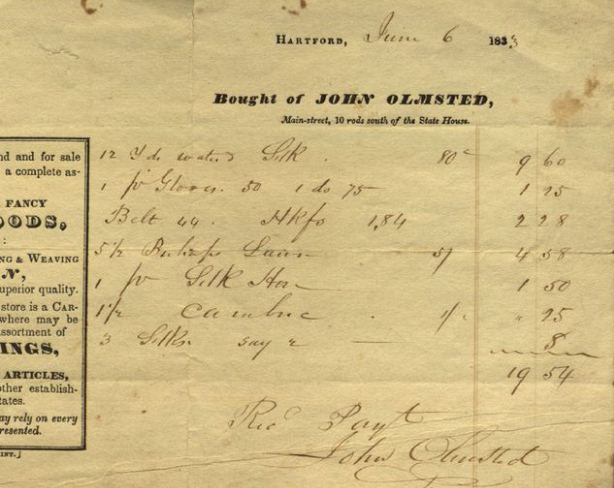By Barbara Austen
Today we do not think of Farmington and Hartford being distant from each other, but in 1839 it was a journey not to be taken lightly. That is why Charlotte Cowles in Farmington wrote frequently to her brother Samuel in Hartford, asking him to do errands for her. On December 5, 1839, she requested that he procure the type of whale bones generally used in bonnets from Mrs. Orcutt, a milliner. Charlotte also asked him to find a yard and three quarters of “backing” to put under the stove in their keeping room. She informed Samuel that the item would be cheaper at Abernathy’s or Chafee’s than at Catlin’s or Olmsted’s and that it should be lighter than their carpet so it wouldn’t show the ashes. Charles Abernathy ran a dry goods store at 212 Main Street. H.B. Chafee & Co. was a few doors down at 217 Main Street and was also a dry goods store. Julius Catlin & Co. was located at 184 Main street while John Olmsted & Co. was nearby at 158 Main Street.

Catherine. Hand-colored lithograph by E.B. & E.C. Kellogg, ca. 1840. Nineteenth-century women wrote a lot of letters. The young woman in this print was a contemporary of Charlotte Cowles – Connecticut Historical Society
The “Great Snow Storm” Limits Travel
One reason travel to Hartford was difficult was the weather, particularly in winter. On December 16, 1839, Charlotte commented on the snow storm they were experiencing. The Hartford Courant referred to it as the “Great Snow Storm.” The snow fell from Saturday night into Monday. “So furious was the gale and the drifting Snow that it was almost impossible to move about the Streets and the depth of the snow rendered locomotion almost impossible. The deep embankments extended even to the second story of houses, and the limbs of trees thrown about every where exhibit the power of the tempest. In the hill towns west of us, we hardly dare indulge the hope of hearing from them again before “thaw time, for the roads are now absolutely impassable . . ..”
Charlotte concurred: “What a storm this has been, is, and, for aught we can see, is to be! It is no 9 o’clock thirty six hours since it commenced. The snow still falls fast, and the winds howl and sweep in every direction.” It was even hard for the sleighs to get around.
Family correspondence offers insight into everyday lives in our past. Charlotte’s letters are among some of the most interesting in our collection. The details such as the “cheaper” stores in Hartford or the difficulty traveling to Hartford in a snow storm just hint at the wealth of information to be gleaned from the 94 letters between Charlotte and Samuel Cowles between 1833 and 1841.
Barbara Austen is the Florence S. Marcy Crofut Archivist at the Connecticut Historical Society.
© Connecticut Public Broadcasting Network and Connecticut Historical Society. All rights reserved. This article originally appeared on Connecticut History | WNPR News
Note: ConnecticutHistory.org does not edit content originally published on another platform and therefore does not update any instances of outdated content or language.








